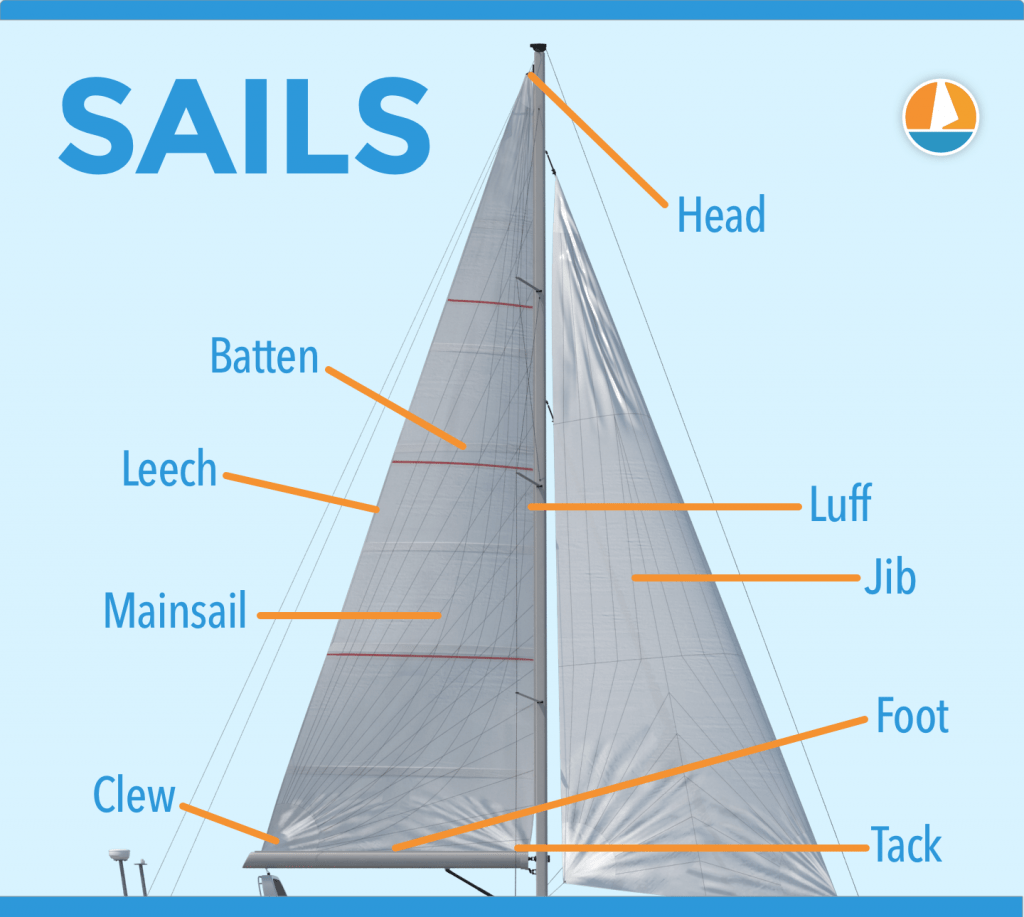Here are some basic terms you should know:
Sheet: A line on a sailboat that pulls a sail in and lets it out.
Halyard: A line on a sailboat that raises and lowers sails. So, if someone refers to a main halyard, that’s the line that will pull your mainsail up and down. There is also a jib halyard, which pulls the jib up and down.
Cleat: This holds your lines for you. You can place a line in a cleat so that you don’t have to keep your hands on it at all times.
And now, a diagram of a 420 sailboat; it’s one of the common boats used in collegiate sailing, and the one I will reference throughout the blog. The red parts of the boat are different lines, and the labels of the parts are in blue.

Parts of the boat explained:
Bow: That’s the front of your boat.
Stern: And, this is the back of your boat.
Hull: Put the front and the back of the boat together, and what do you get? Voila, the whole body of the boat.
Bowline: This is a line in the front of your boat. You can use it to tie up at a dock, or to another boat.
Mast: The mast supports the mainsail and the jib.
Boom: That’s the sound it makes when it hits your head. But, it also supports the bottom part of the main.
Mainsail: This is what powers your boat, plain and simple. The skipper controls this sail. It is referred to as the main.
Jib: This is the crew’s sail. It controls how close to the wind your boat can head. It is important in maintaining the speed of your boat.
Jib sheet: This is what lets the crew pull the jib in, and let it out.
Window: It’s exactly that, a window. It lets you see through the sail and look for anything you may need to see, like another boat coming towards you.
Centerboard: This part sticks out of the bottom of the boat and keeps the boat from sliding sideways through the water. It allows the boat to move forward through the water. It also gives the boat stability.
Rudder: It is in the water and steers your boat.
Tiller: Attached to the rudder, this is your steering wheel.
Tiller extension: An extension of your tiller, this is really what you hold when you are driving.
Main sheet: Can you guess this one? This line attaches to your boat and the boom, and lets you pull your main in and let it out.
Outhaul: This line attaches to the back, bottom corner of your main, and runs along the boom. It pulls the sail out along the boom, towards the stern of the boat.
Downhaul: (Sometimes called a “Cunningham”) This line attaches to the front, bottom corner of your main, and runs along the mast. It pulls the sail down along the mast, towards the bottom of the boat.
Vang: An easy way to remember this part is its shape. It looks like the letter V. This line goes from your mast to your boom. It lets you pull your boom down closer to the boat, making your sail tight and flat. You adjust this depending on how much wind there is.
Batten: These are inside the sail and give the sail a shape. Without these, the sail would be too loose and would not have the shape that is needed to power your boat.
Tell-tales: These tell you the tales of the wind. Get it? Okay, but really, tell-tales tell you what you need to know about your sails. Do you need to pull in your sail, or let it out? Do you need to get closer to the wind or further away? All of the important things you need to know to make your boat go as fast as it can.
Sail Parts:

Parts of the Sails explained:
Luff – A sail’s forward edge. The luff of the mainsail is usually hoisted up and attached to the mast. The luff of the jib is attached to the forestay.
Leech – The sail’s back edge.
Foot – The bottom edge of the sail
Tack – Between the luff and the foot is the tack. The tack is attached to the boat or a spar.
Head – The corner at the top of the sail between the luff and the leech.
Clew – The third triangle of a sail between the leech and the foot.
Batten – Solid slats or rods to help maintain the desired airfoil shape.
Credits:
https://sailingskane.wordpress.com/2013/02/20/hey-whats-that/
https://improvesailing.com/guides/sailboat-parts-explained
